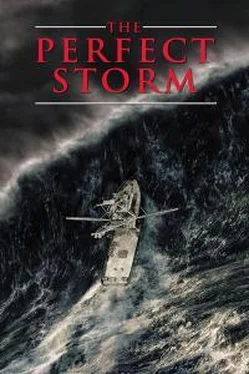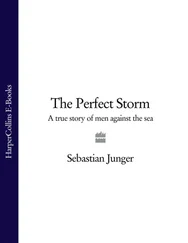Sebastian Junger - The Perfect Storm
Здесь есть возможность читать онлайн «Sebastian Junger - The Perfect Storm» — ознакомительный отрывок электронной книги совершенно бесплатно, а после прочтения отрывка купить полную версию. В некоторых случаях можно слушать аудио, скачать через торрент в формате fb2 и присутствует краткое содержание. Жанр: Триллер, Проза. Описание произведения, (предисловие) а так же отзывы посетителей доступны на портале библиотеки ЛибКат.
- Название:The Perfect Storm
- Автор:
- Жанр:
- Год:неизвестен
- ISBN:нет данных
- Рейтинг книги:3 / 5. Голосов: 1
-
Избранное:Добавить в избранное
- Отзывы:
-
Ваша оценка:
- 60
- 1
- 2
- 3
- 4
- 5
The Perfect Storm: краткое содержание, описание и аннотация
Предлагаем к чтению аннотацию, описание, краткое содержание или предисловие (зависит от того, что написал сам автор книги «The Perfect Storm»). Если вы не нашли необходимую информацию о книге — напишите в комментариях, мы постараемся отыскать её.
The Perfect Storm — читать онлайн ознакомительный отрывок
Ниже представлен текст книги, разбитый по страницам. Система сохранения места последней прочитанной страницы, позволяет с удобством читать онлайн бесплатно книгу «The Perfect Storm», без необходимости каждый раз заново искать на чём Вы остановились. Поставьте закладку, и сможете в любой момент перейти на страницу, на которой закончили чтение.
Интервал:
Закладка:
Johnston's boat takes most of a day to unload, the next day he settles the accounts and starts fitting the boat out again. Food, diesel, water, ice, repairs, the usual. The faster the turnaround, the better—not only will his crew be more likely to survive New Bedford's charms, but it's getting late in the season to head out to the Grand Banks. The longer you wait, the worse the storms are. "You get in that kind of weather and if anything goes wrong—if a hatch busts off or one of the outriggers gets tangled up—you can really be in trouble," says Johnston. "Some of the guys get to where they feel invincible, but they don't realize that there's a real fine line between what they've seen and what it can get to.
I know a guy who lost a 900-foot boat out there. It broke in half and sank with thirty men.
Sure enough, Johnston's still fitting-out when the first ugly weather blows through. It's a double-low that grinds off the coast and cranks the wind around to the southwest. The storm intensifies as it plows out to sea and catches Billy one morning while he's hauling back. The wind is thirty knots and the waves are washing over the deck, but they can't stop working until the gear is in. Late in the morning, they get slammed.
It's a rogue wave: steep, cresting, and maybe thirty feet high. It avalanches over the decks and buries the Andrea Gail under tons of water. One moment they're at the hauling station tending the line, the next they're way over on their side. Heavily, endlessly, the Andrea Gail rights herself, and Billy brings her around into the weather and checks for damages. The batteries have come out of their boxes down in the engine room, but that's about it. That evening Billy radios Charlie Johnson of the Seneca to tell him what happened. Charlie's in Bay Bulls, Newfoundland, getting a crankshaft fixed, and Billy calls him every evening to keep him updated on the fleet. Jesus, we took a hell of a wave, Billy says. We went way over on our side. I didn't think we'd make it back up.
They discuss the weather and the fishing for a few minutes and then sign off. The story of the wave doesn't sound good to Charlie Johnson—the Andrea Gail's known as a tough little boat and shouldn't go over that easily. Not with a bird in the water and twenty thousand pounds of fish in the hold. "I didn't want to say anything, but it didn't seem right," Johnson says. "You're in God's country out there. You can't make any mistakes."
The Andrea Gail fishes east of the Tail for another week and does very poorly, the trip's shaping up to be a total bust. A boat can't stay indefinitely out at sea—supplies run low, the crew gets crazy, the fish get old. They've got to find some fish fast. Around mid-month they pull their gear and steam northeast all night to a set of shallows known as the Flemish Cap. The rest of the fleet is way off to the south and west: Tommy Barrie on the Allison, Charlie Johnson on the Seneca, Larry Horn on the Miss Millie, Mike Hebert on the Mr. Simon, and Linda Greenlaw on the Hannah Boden.
There's also a 150-foot Japanese longliner named the Eishin Maru #78. The Eishin Maru is carrying a Canadian Fisheries observer, Judith Reeves, who is the only person on board who has a survival suit or knows how to speak English. The Mary T is on her way out, and another boat named the Laurie Dawn 8 has just arrived in New Bedford to gear up.
Billy's at 41 degrees west, way out on the edge. He's almost off the fishing charts. The weather has turned raw and blustery and the men work in layers of sweatshirts and overalls and rubber slickers. It's the end of the season, their last chance for a decent trip. They just want to get this thing done.
THE FLEMISH CAP
And I saw as it were a sea of glass mingled with fire . . .
—REVELATION 15
NEW ENGLANDERS started catching swordfish in the early 1800s by harpooning them from small sailboats and hauling them on board. Since swordfish don't school, the boats would go out with a man up the mast looking for single fins lolling about in the glassy inland waters. If the wind sprang up, the fins were undetectable, and the boats went in. When the lookout spotted a fish, he guided the captain over to it, and the harpooner made his throw. The throw had to take into account the roll of the boat, the darting of the fish, and the refraction of light through water. Giant bluefin tuna are still hunted this way, but fishermen use spotter planes to find their prey and electric harpoons to kill them. Giant bluefin are a delicacy in Japan; they are airfreighted over and get up to eighty dollars a pound. A single bluefin might go for thirty or forty thousand dollars.
Spotter planes were introduced to New England fishermen in 1962, but it was the longline that really changed the fishery. For years the Norwegians had caught mako on longlines, along with a few swordfish, but they had never gone after swordfish exclusively. Then, in 1961, Canadian fishermen made some alterations to the gear and nearly tripled the total northeastern sword catch. The boom didn't last long, though; ten years later the U.S.
Food and Drug Administration determined that swordfish carried a dangerous amount of mercury in them, and both the American and Canadian governments banned sale of the fish. Some longliners went out after swordfish anyway, but they risked having their catch seized and tested by the F.D.A.
Finally, in 1978, the U.S. government relaxed the standards for acceptable mercury contamination in fish, and the gold rush was on. In the interim fishing had changed, though; boats were using satellite navigation, electronic fish finders, temperature-depth gauges. Radar reflectors were used to track gear, and new monofilament made it possible to set thirty or forty miles of line at a time. By the mid-eighties, the U.S. swordfish fleet alone was up to 700 boats fishing around fifty million hooks a year. "The technological change appears to be bumping up against the limits of the resource," as one government study put it at the time.
Until then the fishery had been relatively unregulated, but a new drift-entanglement net in the early eighties finally got the wheels of bureaucracy turning. The nets were a mile long, ninety-feet wide, and set out all night from the stern of a converted longliner. Although the large mesh permitted juveniles to escape, the National Marine Fisheries Service was still leery of its impact on the swordfish population. They published a management plan for the North Atlantic swordfish that suggested numerous regulatory changes, including limiting the use of drift nets, and invited responses from state and federal agencies, as well as individual fishermen. A series of public hearings were held up and down the East Coast throughout 1983 and 1984, and fishermen who couldn't attend—those who were fishing, in other words—sent in letters. One of the people who responded was Bob Brown, who explained in a barely legible scrawl that he'd made fifty-two sets that year and there seemed to be plenty of mature fish out there, they just stayed in colder water than people realized. Alex Bueno of the Tiffany Vance wrote a letter pointing out, among other things, that draggers weren't likely to switch over to drift nets because they cost too much, and that swordfish population estimates were inaccurate because they didn't take into account fish outside the two-hundred-mile limit. Sportsfishermen accused commercial fishermen of raping the oceans, commercial fishermen accused sportsfishermen of squandering a resource, and almost everyone accused the government of gross incompetence.
In the end, the Fishery Management Plan did not include a catch quota for Atlantic swordfish, but it required all sword boats to register with the National Marine Fisheries Service, a division of the Department of Commerce. Boat owners who had never swordfished in their lives scrambled for permits just to keep their options open, and the number of boats nearly doubled while, by all indications, the swordfish stock continued to decline. From 1987 to 1991, the total North Atlantic swordfish catch went from 45 million pounds to 33 million pounds, and their average size dropped from 165 pounds to no. This was what resource management experts know as tragedy of the commons, a reference to overgrazing in eighteenth-century England. "In the case of common grazing areas,” explained one fisheries-management pamphlet, "grass soon disappeared as citizens put more and more sheep on the land. There was little incentive to conserve or invest in the resource because others would then benefit without contributing."
Читать дальшеИнтервал:
Закладка:
Похожие книги на «The Perfect Storm»
Представляем Вашему вниманию похожие книги на «The Perfect Storm» списком для выбора. Мы отобрали схожую по названию и смыслу литературу в надежде предоставить читателям больше вариантов отыскать новые, интересные, ещё непрочитанные произведения.
Обсуждение, отзывы о книге «The Perfect Storm» и просто собственные мнения читателей. Оставьте ваши комментарии, напишите, что Вы думаете о произведении, его смысле или главных героях. Укажите что конкретно понравилось, а что нет, и почему Вы так считаете.












